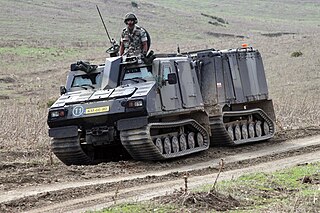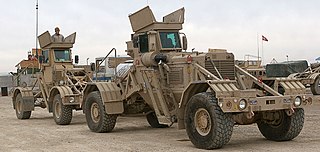
A military engineering vehicle is a vehicle built for construction work or for the transportation of combat engineers on the battlefield. These vehicles may be modified civilian equipment or purpose-built military vehicles. The first appearance of such vehicles coincided with the appearance of the first tanks, these vehicles were modified Mark V tanks for bridging and mine clearance. Modern military engineering vehicles are expected to fulfill numerous roles, as such they undertake numerous forms, examples of roles include; bulldozers, cranes, graders, excavators, dump trucks, breaching vehicles, bridging vehicles, military ferries, amphibious crossing vehicles, and combat engineer section carriers.

The HALO Trust is a humanitarian non-government organisation which primarily works to clear landmines and other explosive devices left behind by conflicts. With over 10,000 staff worldwide, HALO has operations in 28 countries. Its largest operation is in Afghanistan, where the organization continues to operate under the Taliban regime that took power in August 2021.

The Casspir is a Mine-resistant ambush protected vehicle that has been in use in South Africa since the 1980s. It is a four-wheeled, four-wheel drive vehicle, used for transport of troops. It can hold a crew of two, plus 12 additional soldiers and associated equipment. The Casspir was unique in design when launched, providing for passive mine defence. The main armoured steel body of the vehicle is raised high above the ground, so when a mine is detonated, the explosion is less likely to damage the crew compartment and kill the occupants. The cross-section of the hull is V-shaped, directing the force of the explosion outwards, further protecting the occupants.

The RG-31 Nyala is a 4×4 multi-purpose mine-resistant ambush protected infantry mobility vehicle manufactured in South Africa by Land Systems OMC, located in Benoni, South Africa and in Turkey by FNSS Defence Systems. It is based on the Mamba APC of TFM Industries.

The Buffel is an infantry mobility vehicle used by the South African Defence Force during the South African Border War. The Buffel was also used as an armoured fighting vehicle and proved itself in this role. It replaced the older Bedford RL-based Hippo APC and itself was replaced by the Mamba from 1995 in South Africa, but remains in use elsewhere, notably Sri Lanka.

The FV107 Scimitar is an armoured tracked military reconnaissance vehicle formerly used by the British Army, until it was retired from active service in April 2023. It was manufactured by Alvis in Coventry. It is very similar to the FV101 Scorpion, but mounts a high-velocity 30 mm L21 RARDEN cannon instead of a 76 mm gun. It was issued to Royal Armoured Corps armoured regiments in the reconnaissance role. Each regiment originally had a close reconnaissance squadron of five troops, each containing eight FV107 Scimitars. Each Main Battle Tank Regiment also employed eight Scimitars in the close reconnaissance role.

Hobart's Funnies is the nickname given to a number of specialist armoured fighting vehicles derived from tanks operated during the Second World War by units of the 79th Armoured Division of the British Army or by specialists from the Royal Engineers.

The LAV III is the third generation of the Light Armoured Vehicle (LAV) family of armored personnel carriers built by General Dynamics Land Systems – Canada (GDLS-C), a London, Ontario, based subsidiary of General Dynamics. It first entered service in 1999, succeeding the LAV II. It is the primary mechanized infantry vehicle of both the Canadian Army and the New Zealand Army. It also forms the basis of the Stryker vehicle used by the U.S. Army and other operators. The Canadian Army is upgrading its LAV IIIs to the LAV 6 standard. Early in its development history it was referred to as the 'Kodiak', but the name was never officially adopted.

Demining or mine clearance is the process of removing land mines from an area. In military operations, the object is to rapidly clear a path through a minefield, and this is often done with devices such as mine plows and blast waves. By contrast, the goal of humanitarian demining is to remove all of the landmines to a given depth and make the land safe for human use. Specially trained dogs are also used to narrow down the search and verify that an area is cleared. Mechanical devices such as flails and excavators are sometimes used to clear mines.

A mine flail is a vehicle-mounted device that makes a safe path through a minefield by deliberately detonating land mines in front of the vehicle that carries it. They were first used by the British during World War II.

The region of Nagorno-Karabakh and areas around it are considered to be some of the most heavily mined regions of the former Soviet Union. Mines were laid from early 1990s by both Azerbaijani and Armenian forces during and after the First Nagorno-Karabakh War. The worst-affected areas are along the fortified former contact line between Azerbaijani and Armenian forces, in particular in the districts of Aghdam, Fuzuli and Jabrayil. According to military experts from both Azerbaijan and Armenia, the ground in those areas is covered with "carpets of land mines." The region has the highest per capita rate in the world of accidents due to unexploded ordnance.

The Sisu RA-140 DS "Raisu" is a flail-type demining vehicle developed and produced by the Finnish company Sisu-Auto and later produced by Patria Vehicles in the years 1994–2001. The production totalled 41 units.

The Iveco LMV is a 4WD tactical vehicle developed by Iveco, and in service with several countries. After its adoption by the Italian Army as the Veicolo-Tattico-Leggero-Multiruolo (VTLM) Lince, it won the Future Command and Liaison Vehicle (FCLV) competition of the British Army as the Panther, but the fleet was put up for sale in 2018.

The BvS10 is a tracked articulated amphibious all-terrain armoured vehicle produced by BAE Systems Land Systems Hägglunds of Sweden. This vehicle, referred to as the All Terrain Vehicle (protected) - ATV(P) or Viking by the UK forces, was originally developed as a collaboration between industry - Hägglunds Vehicle AB - and the British Ministry of Defence (MoD) on behalf of the Royal Marines.

The Husky VMMD is a configurable counter-IED MRAP vehicle, developed by South African-based DCD Protected Mobility and American C-IED company Critical Solutions International. Designed for use in route clearance and de-mining operations, the Husky is equipped with technologies to help detect explosives and minimise blast damage.

The Trojan Armoured Engineer Vehicle (AEV) is a combat engineering vehicle of the British Army. It is used to breach minefields and for many other tasks. It is currently in use with the Royal Engineers.

The Mine Protected Combat Vehicle – MPCV was a Rhodesian 4×4 Infantry fighting vehicle (IFV), first introduced in 1979 and based on the body of the Mercedes-Benz Unimog light truck. It remains in use with the Zimbabwe National Army.
The Crocodile Armoured Personnel Carrier or "Croc" is a Rhodesian armoured personnel carrier first introduced in 1977 and based on Japanese commercial trucks' chassis. It remains in use with the Zimbabwe National Army (ZNA).

The Aravis is an infantry mobility vehicle developed and built by French company Nexter. An order for 15 Aravis vehicles was placed by the Délégation Générale pour l'Armement in April 2009 for use by the French Army as a reconnaissance and escort vehicle for engineer units. Deliveries for the initial order began in January 2010.
MineWolf Systems provides machines and services for the mechanical clearance of landmines and other explosive devices. Its customers are mine clearance agencies in the commercial, humanitarian and military demining field. British company Pearson Engineering Ltd, a leading provider of Combat Engineer equipment, announced acquisition of the IP and Assets of MineWolf Systems in 2016.



















